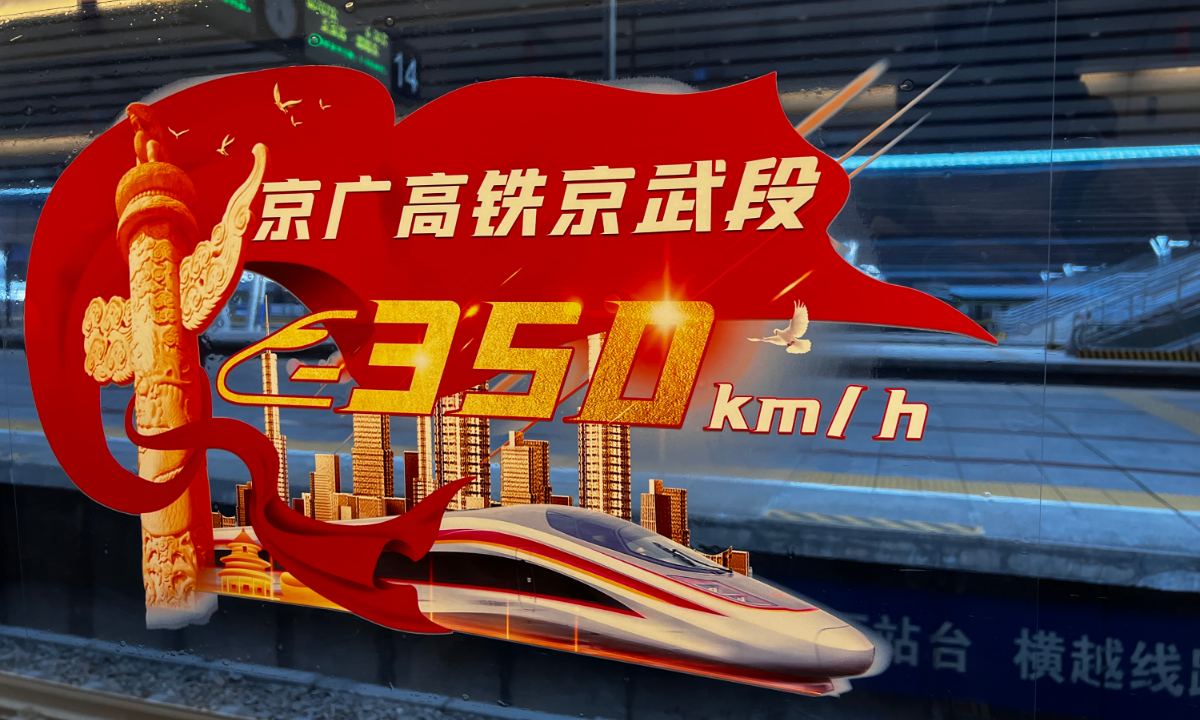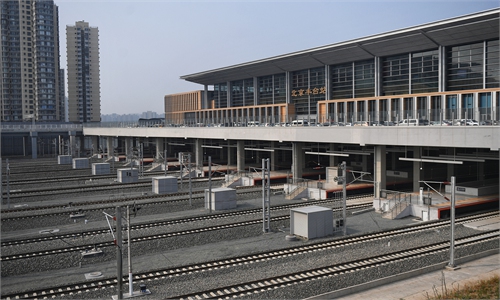Beijing-Wuhan high-speed railway route upgrades speed to 350 km/h, serves as a major economic corridor for inland Chinese cities

Beijing-Wuhan high-speed railway route upgrades speed to 350 km/h from June 20. photo: Tao Mingyang/GT
A major Chinese high-speed railway route has realized a speed upgrade as of Monday, which is expected to enlarge the transport capacity, shorten traveling time and serve as a major economic corridor for inland Chinese cities, marking another milestone for China’s infrastructure construction and boosting the nation’s economic vibrancy following the pandemic being brought under control.
The high-speed railway between Beijing and Wuhan, Central China’s Hubei Province, a section of the Beijing–Guangzhou high-speed rail link began operation at a standard speed of 350 km/h from 310 km/h on Monday, the fifth major railway route to reach the level of speed, which will further strengthen the regional and economic connection between the inland Chinese cities, according to China State Railway Group Co, the country's railway operator.
A Global Times reporter experienced on the train from Beijing and to Zhengzhou, central China’s Henan Province on Monday, the first day since the speed upgrade on the route.
After a burst of acceleration, the speed of the train reached over 350 km/h from less than 200 km/h in a few minutes, the Global Times reporter observed. Some passengers were seen placing water bottle upside down on their tray tables to test the stability of the high-speed train.
The speed upgrade on the route will increase the transport capacity of the route by 7 percent, equivalent to adding 15 high-speed trains from Beijing to Wuhan every day, or an increase of 18,000 seats, China Railway confirmed.
Operating as the main rail network in central China the Beijing-Wuhan railway section connects 12 high-speed railway lines and traverses the core regions covering the Beijing–Tianjin–Hebei Region, city clusters in the central China and along the middle and lower reaches of the Yangtze River, Zheng Pingbiao, a research fellow with China Academy of Railway Sciences (CARS) told the Global Times on Monday.
“These are the key economic development regions in China. Strengthening connectivity between cities in this region is of great significance to the nation’s economic and social development,” Zheng said.
The closer connection will also shorten people’s traveling time, boosting tourism along the line and making good use of the tourism resources in the region.
“It will be convenient for people to travel to Songshan Mountain in Central China's Henan Province, Southwest China's Chongqing and other tourist landmarks along the route, which can promote the development of tourism resources of provinces and cities along the line,” Zheng said.
A passenger surnamed Li, one of the first passengers to board the train on Monday told the Global Times that his strongest feeling was the increased speed of the train and expected it to facilitate more travel opportunities for local residents.
Li boarded the train from Beijing heading for Zhengzhou.
“I like Chongqing and Chengdu very much. It only takes half a day to travel from Zhengzhou to Chongqing after this speed upgrade,” Li said.
With the speed upgrade the traveling time from Beijing to Wuhan has been reduced to 3 hours and 48 minutes. The traveling time from Beijing to Chongqing will be reduced to 6 hours and 46 minutes and time to cities in northwest China such as Xi’an and Lanzhou has been reduced to 4 hours 11 minutes and 6 hours 24 minutes respectively.
The speed upgrade on the Beijing-Wuhan section of Beijing-Guangzhou high speed railway followed the Beijing-Shanghai high-speed railway, the Beijing-Tianjin intercity railway, the Beijing-Zhangjiakou high-speed railway and the Chengdu-Chongqing high-speed railway which earlier had successfully realized normal operation at 350 km/h, with a total length of nearly 3,200 kilometers.
Also on Monday, Beijing Fengtai Railway Station, the largest railway hub in Asia resumed operation, another breakthrough in China’s infrastructure construction after four years renovation and construction.
The reconstructed station has a gross floor area of nearly 400,000 square meters. It will be able to accommodate a maximum of 14,000 passengers per hour.
The station will serve as the terminal for multiple arterial train lines in China, such as the Beijing-Guangzhou High-speed Railway and Beijing-Kowloon Railway and will serve 120 trains during its preliminary stage of operation.
Beijing Fengtai Railway Station was built in 1895 in southern Beijing's Fengtai District. It has been used to provide both passenger and freight services until its closure in 2010. Reconstruction of the station commenced in September 2018.

